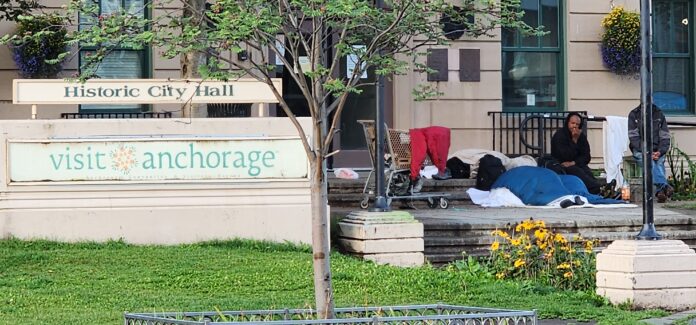
While Alaska buzzes with speculation about where President Donald Trump and Russian President Vladimir Putin will meet on Aug. 15, one thing is certain: The anti-peace protesters are already mobilizing in Anchorage.
The “No Kings” movement — a loose coalition of Democrats, radical anarchists, the Occupy movement, and members of the Party for Socialism and Liberation — is organizing what could be the largest protest in Alaska history. Others, such as the MoveOn group and the new 50501 alliance will likely take part.
Their aim is not to welcome peace talks, but to disrupt them and make them fail. Communists, evidently, do not support dialogue.
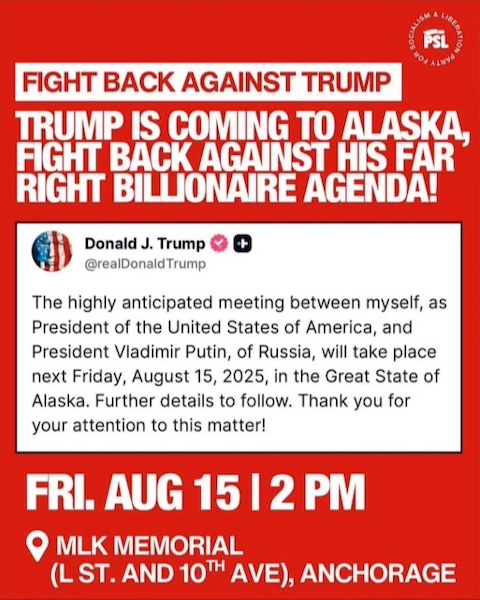
On social media, the group is circulating a bright-red flier calling for people to “Fight Back Against Trump” and oppose what they call his “far-right billionaire agenda.” The rally is scheduled for 2 pm Friday at the Martin Luther King Jr. Memorial in downtown Anchorage, just blocks from the city’s worsening homeless encampments. Downtown may be a place that regular citizens want to avoid on Friday for all kinds of reasons, since it’s not clear Anchorage police are equipped to handle the crowds.
Despite the No Kings movement’s claims of standing up for “the little guy,” their opposition to Trump and Putin even meeting exposes a deeper hypocrisy: They are willing for the war in Ukraine to drag on indefinitely, with ordinary people paying the price in blood. Rather than support a chance for dialogue, they are aligning themselves with endless conflict and with the powerful war industry that benefits from it.
The “No Kings” name reflects their rejection of any strong leader, but in practice, their protests have become more about spectacle than substance. They crave attention, and with international media descending on Alaska, they will get it.
Since reporters from around the globe will not be allowed inside the actual Trump-Putin meeting, wherever it is being held, they will have to look for something else to send back to editors and producers, if only to show that they are working.
Media consumers from London to Moscow to Tokyo will be fed the images of angry signs, bullhorn speeches, and choreographed outrage of a small but loud faction.
And while the protesters occupy the stage, another image will define Anchorage for the world: the vagrants and drug-addicted Alaskans encamped across downtown. Anchorage Mayor Suzanne LaFrance has shown little effectiveness in addressing the crisis, leaving it to fester just in time for the biggest influx of foreign press the city has seen in decades. There may be a big cleanup this week, with the sides of buildings being pressure washed and painted to cover the urine, poop, and vomit that festoons them.
The result? The international narrative about Alaska could end up being less about history-making diplomacy, and more about a city in disarray and a state whose most visible citizens are shouting “No” to peace.
Here’s a small sample of what Must Read Alaska’s lens captured on Monday morning we walked the downtown Anchorage business and entertainment district:
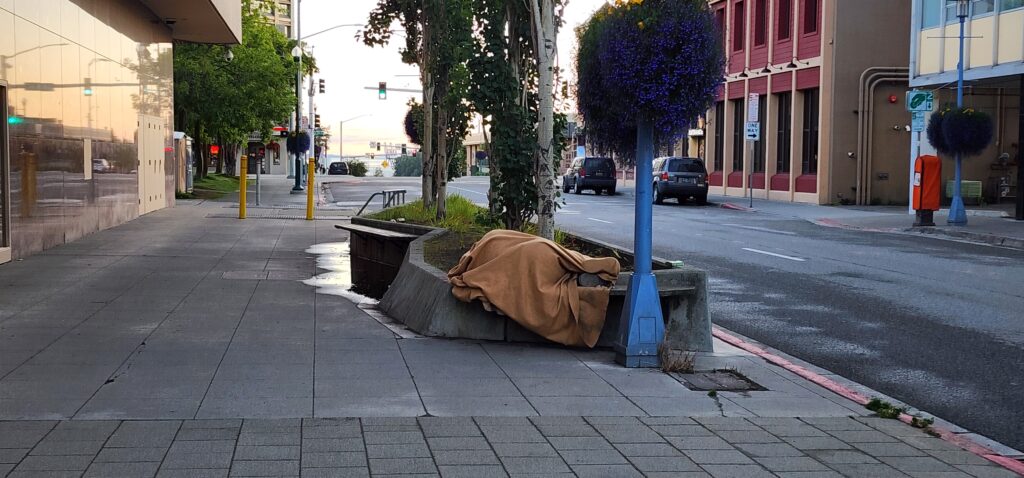
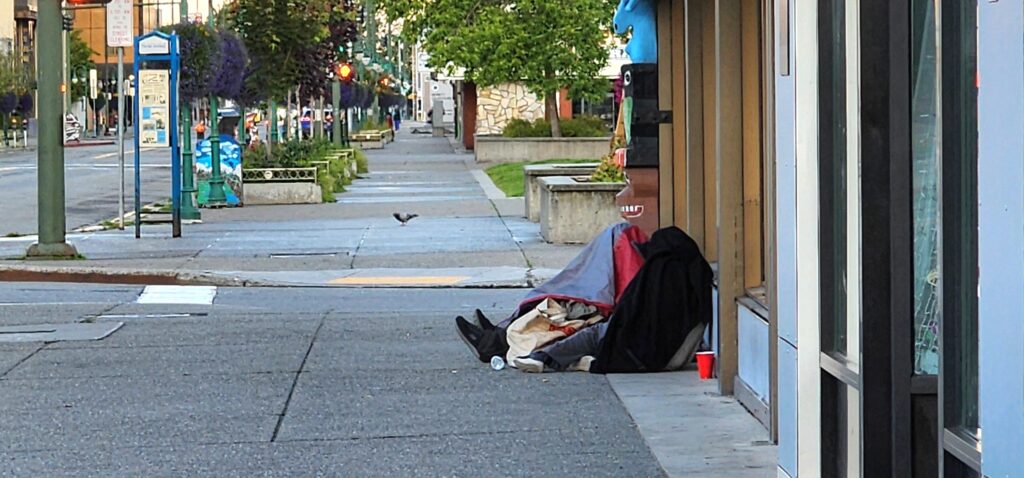
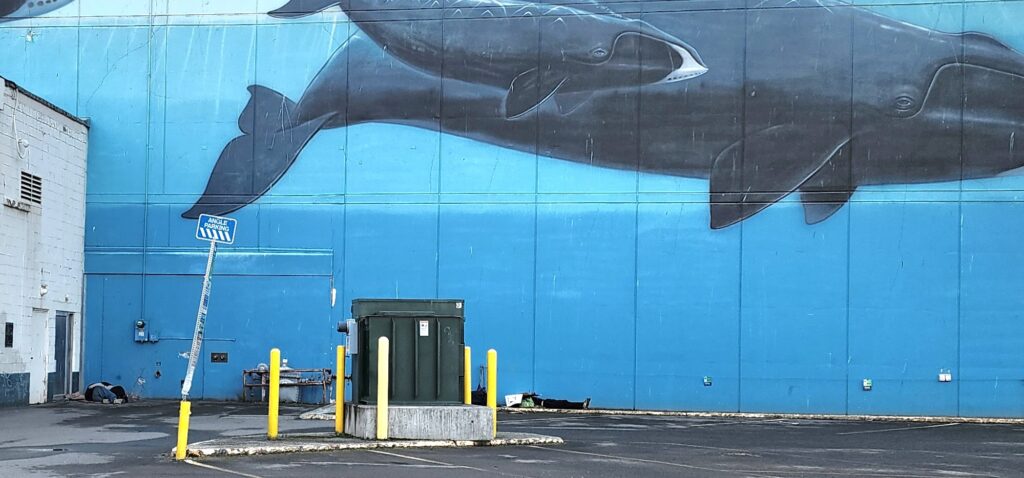
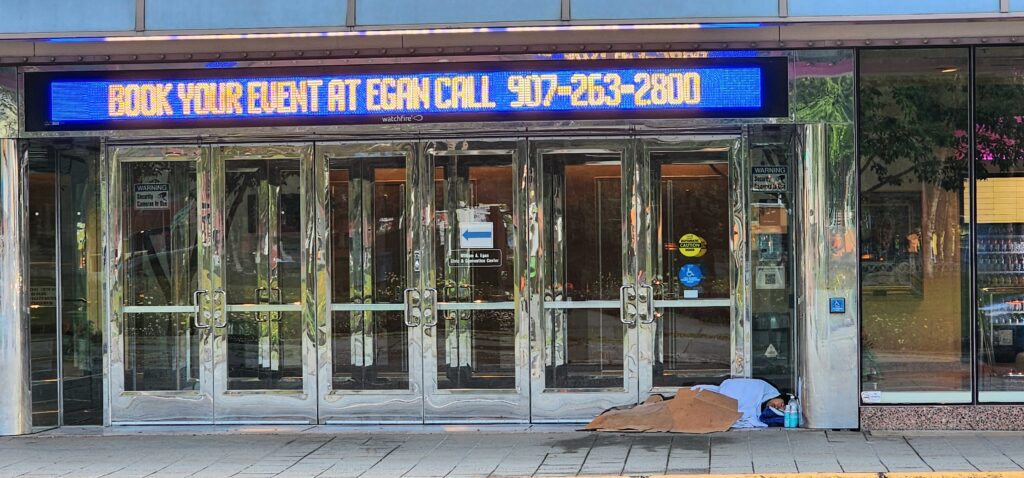
On Friday, the world will be watching. Whether it sees an Alaska that embraces diplomacy or one that rejects it outright depends not on the location of the summit, but on the protest scenes playing out in the streets for the enjoyment of the New York Times, Washington Post, and the BBC.
They are actually protesting against free and fair elections, you know, our American system. Commies are as commies do.
This will be good, Now Trump can see for himself the morons we have in Juneau
Video all of them. We need to identify the enemy.
👍
Leftists do not care who gets hurt, just as long as they get to be in power. That is what they are all about. They would rather rule over the ashes of the country than allow someone other than themselves to be in charge.
It is all about worshiping at the altar of the All-Powerful State, and forcing everyone to obey their wants and will.
You’ve just perfectly described Trump.
If you say so.
.
I also notice you did not dispute my comment. I guess that means you agree, leftists are all about power, regardless of the consequences.
If you say so.
I do.
And, you had a perfect opportunity to rebut my statement and demonstrate the left is not 100% all about gaining and keeping power. Instead you provide nothing.
And you have just perfectly displayed your ignorance, your hypocrisy and your idiocy.
CBMTTek is exactly correct, and you know it: for radical leftists, the pursuit and exercise of raw, naked power is their end-all and be-all. That is indisputable.
TDS much Cman?
So original. I think many people on here think any criticism or disagreement with Donald Trump automatically equals TDS. It’s lazy logic; and I’m using logic here in the loosest possible way.
This comment is pretty amusing. We are experiencing unprecedented federal control and you blame the other party for wanting the “All Powerful State.” Control of universities, private law firms, media organizations, Washington DC, and the list goes on. If you like these policies that is one thing, but lets be real about federal power and the reach of the “All Powerful State” happening right now.
Enforcing the terms and conditions of a grant, and controlling a university are two very different things. If you can’t see the distinction that on you.
I just hope you feel the same way if a future Democratic president takes office and decides to strip a conservative college like Liberty University of their federal grants because they don’t like their politics. That’s exactly what Trump is doing.
You think President Trump is stripping the colleges of their grants because he disagrees with their politics? If that were the case, no college in CA or MA would receive a penny of Federal grant money.
.
Not the case. The colleges have violated the terms of their grant conditions. If they did not, and this was strictly political, the grant would be restored immediately by any judge, no matter how conservative. Reality disagrees with your assessment.
.
Now, yes, I would be OK with a Democrat President stripping a conservative college of a grant for the same reason, a violation of the grant conditions. I would not be OK for them doing so because they are throwing a tantrum.
You’re wasting your time trying to reason with the MAGA crowd here.
Remove the log from your own eye, Cman
Trump is reducing federal regulations at an unprecedented rate. He’s reducing federal power.
He wants unlimited power to the executive branch of the government. That’s not reducing federal power in any meaningful way. Just the opposite.
What he wants and what he is doing are two very different things.
And, how do you know what President Trump wants? Are you a mind reader? Never mind, you would never answer.
.
So far, Trump has a near perfect record, every action he has taken is within the legal authority of the Executive branch. Yes, lower courts have issued TROs, and injections, only to see them all overturned upon appeal.
.
Exercising the Constitutional authority the Executive branch is endowed with is not grasping for unlimited power.
It might be the end of our much-vaunted Green Tourism economy. Anchorage: Air-Crossroads of the World, indeed! The Left is reaping their own urinary & fecal mess. Let’s see if the press will try to blame Dunleavy (who conveniently has an “R” next to his name) for the city’s vagrant problem, instead of where it belongs.
Suggest underscoring The Russian American Company and having it in Kodiak or Sitka.
Crazy world we live in. When the Baby Boomers were teenagers, they were rabidly anti-war and rightly so. Now – 50 years later – they are avidly pro-war! Go figure. Must have been all the booze and drugs!
The point is they are always “the smart kids”
We should always do what they (& Hilllary) tell us to do, no matter what
End war, support war doesn’t matter ….. they’re the smart kid
(& now they’re out of power …. lol ….. this is SO funny)
I for one hope it is a huge blackeye for San FranAnchorage. What a chit hole.
What’s wrong with the “far right billionaire agenda?” It’s much preferable to the far left billionaire agenda – cashless bail, pro-criminal D.A.s, open borders, human trafficking, etc.
Park Strip! (that grassy paradise) Will there be food trucks?
Show some courage and line Boniface Parkway for a couple of miles & support local business there.
Do something useful for once.
At some point, particulars for the meeting will be announced. I predict that most, if not all, of the events and happenings will take place on JBER. The base will be locked down as never before. The use of deadly force will be authorized. Advance teams are already here or will be arriving soon and will include teams from Comrade Vladimir. The Muni will play a minor role with most of the local effort focused on controlling local protests. The media circus will start soon. Oh, don’t forget the lengthy shut-down of air commerce.
There are many interests with far more power than street protesters that absolutely do not want a “peace” treaty or architecture between the USA and the Russian Federation.
The entire American strategy subsequent to achieving near total global hegemony since 1991 has been to maintain it and eliminate any peer or near peer economic let alone military competitor. Particularly China, Russia and to a lesser extent Iran. The biggest opponents to a peace deal are in our own government, which remains the same through all presidential administrations since Bush Sr.
Just look at who Trump has surrounded himself with and the incredibly disingenuous advice they give for Trump who claimed his goal was to disentangle us from foreign entanglements and work on our own country.
We have had a continuity of agenda as spelled out in numerous NGO papers, Rand Corporation, Heritage Foundation and Institute for Democracy, among others, delineating how to topple, meddle and eliminate any government that is sovereign and not dominated by the US.
The problem presented by the Ukraine project is that it failed to weaken Russia and cause regime change replaced by a subservient regime as under Yeltsin, allowing the US and business interests to plunder their country. Instead it is siphoning off weapons and increasing our debt at a rapid rate for which is needed to confront China.
The US planned and initiated failed brutal assassination of leaders coup against Iranian leadership and subsequent pummeling of Israel with Iranian missiles also depleted our missile interceptors and worse, displayed in real time, how far behind the technology curve our MIC is, along with the inability of surge production in modern conflicts, this isn’t 1991 any longer.
It is inconceivable that Washington is prepared to deal with the root causes of our war of aggression against a sovereign Russia using Ukraine as a proxy, a war which in economic, military, industrial capacity and available Ukrainian manpower terms we have lost. With the blood and treasure Russia has vested in this war, their leadership has a duty to the Russian people to end the conflict on the battlefield to secure their borders from the Euro/NATO vassals, all of which have abandoned democracy or economic viability.
There will likely be very dramatic operations launched against Russia from Ukraine, the Baltics or Finland to disrupt this summit in the coming days or hours. The Russians have recently been eliminating concentrations of Ukrainian drone operators and drones and troops staged very near the Belgorod border. Another Spiderweb, Crocus City Hall or Breslan school massacre type operation may also be unleashed, planned by our CIA and executed by the SBU.
It seems reckless to trust the security in our country for the safety of the Russian president as we vividly saw there were 2 close calls against Trump during the election.
Brian, the United State and our allies fought long and hard to win the cold war against the communist Soviet Union. Communists were, and are, our enemy. Communists were the ones who hated free speech, freedom of religion, or any of the economic freedoms we enjoy with a free market.
Your little gangster, Putin, was and is a dedicated communist. Putin had to be a dedicated communist in order to get his KGB job.
Putin hates, hates, hates, the fact that the communist Soviet Union collapsed, and was dismantled (except for the part about how he was able to steal hundreds of billions of dollars during the collapse.)
I’m proud to tell you I fought against the communists in the cold war.
In the near future Russians will rid themselves of the gangster/communist Putin. Then, maybe this will begin the last chapter of the fall of the evil, communist dictators that brought so much death and destruction to our world.
It is apparent you have no idea what Russia is currently and that no one under 40 there knows communism. It was a 70 year aberration in a nation-state over 1,000 years old.
We have far more hybrid arm chair Marxists in our University faculties than in Russia.
After replacing the British Empire in 1945 and almost reaching world hegemony in 1991, the American Empire is rapidly failing.
The serious issues facing a cohesive American people and loss of prosperity we have are domestic. The Soviet menace is a historical relic in the way a Constitutional Republic here has long since been gone.
And yet, they still have thousands of nuclear ICBMs aimed at us, not exactly a re!ic
“…….Their aim is not to welcome peace talks, but to disrupt them and make them fail. Communists, evidently, do not support dialogue………”
I think that’s hype. Most of the groups you cited would protest just about anything, and just want exposure and chaos, regardless the issue. They’re revolutionaries.
I don’t oppose negotiations with Putin. I simply see them as a complete waste of time and effort, and potentially just another of Putin’s bomb craters for Trump to fall into. Even then, I relish the side show just for the peaceniks to come out the other side covered in pirozhki…………….again. Moreover, the longer Putin plays, the more he gets his fanny whipped. Let the whupping proceed.
I doubt Putin and Trump will leave JBER. But the commies still need some stiff opposition on the street. And everywhere else.
Trump stated in his news hour on the DC federal law enforcement take over that he, Trump would meet in Russia with Putin. Too many objections to Putin in Alaska and the USA. Listen to that broadcast.
Do the Leftists have any meaningful employment? How do they provide a living for themselves when they are always assembling to protest Trump? The Devil’s workshop is full of people with too much time on their hands.
Assembling to protest Trump IS their employment.
The same could be said for the thousands who flock to Trump rallies. Cult of personality.
The difference is the average Trump supporter has to take time off of work to attend a rally, whereas the anti-Trump crowd is paid to be there.
You mean the hard working America loving people who actually want this country to succeed who attend Trump rallies?
Well, you are, as well as everyone else who’s trying to eek out a living. I figure each of us are carrying at least seven of those parasites on our backs.
“Why do the heathen rage…?,” asked the Psalmist (David, son of Jesse) about 3,000 years ago. His thoughtful consideration of the question remains instructive to us.
Today’s leftist-progressive-anarchist-socialist-Marxist-mishmash of malcontents enjoy what their preferred governments of China, Gaza, Venezuela, and Cuba do NOT permit, which is the right to cause a commotion and to make bloody fools of themselves in street protests.
In due time, David warns, the ragers will be broken by a rod of iron. This will not happen at the direction of any present or future president of the USA, but by the One who will rightfully rule on this Earth. Can we both scorn and pity these ragers?
This article is a confused plot twist, Suzanne. Homeless bums continue to be a problem in leftist Anchorage. That’s old news.
There are anti-Trump protestors just about everywhere, but that’s not really news, is it?
You offer no evidence- only your opinion- that people don’t want peace. Maybe its true, but a good journalist would offer up proof. You offer nothing.
Decent Alaskans don’t want a psychopathic murder in Alaska. Putin is no different that Hitler. One can’t fix these nut jobs. The only way these twisted men stop hurting others is when they die, or are placed in a jail cell.
Think of it this way. Its 1944, and Hitler makes demands about what the USA should do. Hitler wants to “negotiate”. Some of you would think negotiating with Hitler would be a great idea. But rational people know the only way to stop pure evil is to destroy it.
Putin started this war. Putin is directly responsible for the death and injuries of around one million Russians. Putin routinely orders attacks on civilians. Putin is a gangster that orders his Russian opponents to be murdered (Navalny). Putin and his gangster regime has looted over one trillion dollars from the Russian people.
There is no discussion with this madman that is going to make him less evil. He is not welcome in my state. I’m speaking as a veteran, a Republican, and one who has decades of public service.
Trump has made foolish claims like he would end this war in 24 hours. Trump also claims he wants to take Canada and make it a US state- thereby ensuring a Republican would never win the White House ever again- due to the electoral college rules and the fact the Canadian “state” would vote with California and other liberal states. Pure madness. Trump is destroying the Republican brand.
Now do Zelensky. Be objective and truthful.
Your demons will prevent it.
So, you’re advocating for war? Trump is no Neville Chamberlain nor a Mussolini (despite being mockingly called a fascist). The purpose of this meeting is to get Putin to the table. Trump cannot surrender Ukrainian lands which is what Putin is pursuing. Trump will communicate with Putin, then it will be on to Zelinskyy. There’s no one better at this than Trump. Remember the brief Cambodia/Thailand skirmish? Trump ended that in a day.
“Trump also claims he wants to take Canada and make it a US state”
And… you just lost all credibility right there.
.
Anyone with half a functioning brain cell knew instantly that claim was nothing more than trolling the left. And you are buying into it.
.
“Trump is destroying the Republican brand.”
Good. The republicans are nothing more than democrats pretending to be conservatives. There is a reason why the word ‘uniparty’ exists, and the current members of the Republican are that reason. Now.. the republicans can do exactly what you are doing, whine and wish for yesteryear, or they can step up and do what we expect Republicans to do. Cowtowing to the left is not it.
CBM, Trump’s insane claims about making Canada the 51st state were way more consequential than trolling. The end result was that Canadians elected another left wing PM, instead of the conservative PM that was expected to win the election- until Trump started flapping his gums.
Reagan was way smarter than Trump, and this bad result would never have happened.
Peace, through strength. Ever heard that before?
Canadians had their dubious Prime Minister SELECTED for them using the same computerized voting machines that have been subverting honest and fair elections worldwide, for over two decades now.
Good point there, North.
I refuse to believe thousands of conservatives changed their vote because Trump make a comment about turning Canada into the USA’s 51st State. That is just unrealistic to the point of parody. Somehow, I think your scenario is a lot more likely. The current PM would be selected regardless of what Trump said.
.
Now, I also acknowledge the voting public does not select the PM, the Canadian Parliament does. But, seriously, the MPs are, like all politicians, too afraid of losing the next election to vote against the wishes of their constituents on such a weighty matter. So, my statement remains. I do not see thousands of conservatives telling their conservative MPs to vote for a leftist. Not happening.
That’s weird, I just saw something that said most of Canada, at least the western parts are seriously considering breaking from Ottowa and the leftists.
.
In other words Toronto and Montreal elected that leftist.
.
But you keep on believing what you want.
No, we started it in in the early 90s and graduated to taking full control in 2014 when we futzed around in Ukraine’s elections, facilitated The Maydan Massacre, then the Orange Revolution, and allowed Ukraine to shell their own people for seven years. 🙄
I speak as the same as you.
Putin started nothing. Ukraine was overthrown by our very own CIA, and Zelenskyy was put in power. He has since shut down elections. Zelenskyy then decided to threaten to join NATO, a direct threat and provocation to Russia, and he knew what he was doing. That is why he is stonewalling peace. His riches and very existence is predicated on us supporting him. Madness is when leftist idiots try to do international politics. Every thing the touch turns to crap.
Tamra, how many rolls of tin foil are you wearing?
A sizeable percentage of the estimated $500 billion in cash and weapons we send are stolen.
As the Ukranian SBU was created, trained and is directed by our CIA, all of this is well known. Arms are sold through Kosovo, Moldova and Romania. And are showing up with cartels on our border with Mexico.
With Ukraine literally running out of living men, who still have all their limbs, to abduct off the streets and send to their demise, cartel members from Colombia and Mexico are being recruited as contract soldiers.
By the Segurcol Ltd in Medellín snd other agencies. Any of these mobsters who survive will have been trained on modern drone warfare and NATO/American weapons and experience in how NATO manages military units.
Militarized narco cartels on our border, the Ukraine debacle, the gift that keeps on giving.
Think of it this way. Its 1944, and Hitler makes demands about what the USA should do. Hitler wants to “negotiate”. Some of you would think negotiating with Hitler would be a great idea. But rational people know the only way to stop pure evil is to destroy it.
So in your metaphor Ukraine is Hitler, about to be defeated, and Putin is the USA. Are you sure that’s what you intended?
Reagan – You can have your own opinion, but you cannot change the facts. This war was started back in 2014 when the Obama/Biden administration gave the green light to the CIA to violently overthrow the legitimately elected government of Ukraine. The resulting years long civil war resulted in thousands of civilian causalities, mainly amongst the Russian speaking residents of Eastern Ukraine and finally culminated in the Russian Special Military Operation in February of 2022, which stated goal was to protect the civilian residents in the Donbass from Ukrainian Azimov Battalion neo-Nazis. It has degenerated into a full-blown proxy war between Russia & NATO. Zelensky is only a puppet in a would be vassal state.
“……. the Obama/Biden administration gave the green light to the CIA to violently overthrow the legitimately elected government of Ukraine………”
Yeah, that’s what some folks say, but I’ve been watching the CIA try desperately to overthrow a moron like Trump for the past 9 years, and I’m not impressed. You’re having a difficult time convincing me that they can overthrow anybody if they can’t do it to a single guy hated by over half the nation, included most in his own party, but go ahead; it looks like you’ve got plenty of stupid Americans convinced (or you’re one of the stupid Americans who has been convinced by…………somebody………….)
Maybe Trump will call in the FSB to remove the homeless
And, if he did, I am sure the leftists will complain anyway.
Useful idiots do what useful idiots do, a few of the commentators here will likely be in the crowd of “protesters”. In reality these useful idiots are just following marching orders by those who command the mob of leftists. It’s easy to spot a useful idiot by the way they parrot the exact same talking points given to them by their masters.
I hope Trump and Putin meet at a hangar on Elmendorf, like Nixon and Hirohito did because it will lend less distraction to the meeting and would be much easier to control than bringing the whole parade into downtown Anchorage.
I also hope that Trump and Putin will land at Jber, completely missing the tragic and disgusting eyesore that Alaska’s largest city has become.